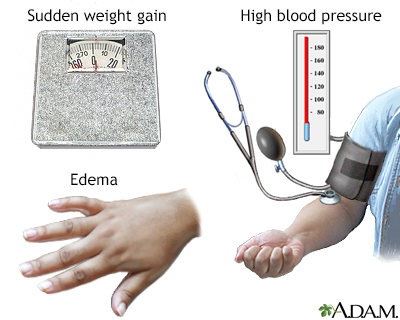Pregnancy SmartSiteTM
Toxemia; Pregnancy-induced hypertension (PIH); Gestational hypertension; High blood pressure - preeclampsia DefinitionPreeclampsia is high blood pressure and signs of liver or kidney damage that occur in women after the 20th week of pregnancy. While it is rare, preeclampsia also may occur in a woman after delivering her baby, most often within 48 hours. This is called postpartum preeclampsia. CausesThe exact cause of preeclampsia is unknown. It occurs in 3% to 7% of all pregnancies. The condition is thought to start in the placenta. Factors that may lead to preeclampsia developing include:
Risk factors for the condition include:
SymptomsOften, women who have preeclampsia do not feel sick. Symptoms of preeclampsia can include:
Note: Some swelling of the feet and ankles is considered normal during pregnancy. Symptoms of severe preeclampsia include:
Exams and TestsThe health care provider will do a physical exam. This may show:
Blood and urine tests will be done. This may show:
Tests will also be done to:
The results of a pregnancy ultrasound, non-stress test, and other tests will help your provider decide whether your baby needs to be delivered right away. Women who had low blood pressure at the start of their pregnancy, followed by a significant rise in blood pressure need to be watched closely for other signs of preeclampsia. TreatmentPreeclampsia usually resolves within 6 weeks after the baby is born and the placenta is delivered. However, it may persist longer or even begin after delivery. Most often, at 37 weeks, your baby is developed enough to be healthy outside of the womb. As a result, your provider will likely want your baby to be delivered so the preeclampsia does not get worse. You may get medicines to help trigger labor, or you may need a C-section. If your baby is not fully developed and you have mild preeclampsia, the disease can often be managed at home until your baby has matured. The provider will recommend:
Complete bed rest is no longer recommended. Sometimes, a pregnant woman with preeclampsia is admitted to the hospital. This allows the health care team to monitor the baby and mother more closely. Treatment in the hospital may include:
You and your provider will continue to discuss the safest time to deliver your baby, considering:
The baby must be delivered if there are signs of severe preeclampsia. These include:
Outlook (Prognosis)Signs and symptoms of preeclampsia most often go away within 6 weeks after delivery. However, the high blood pressure sometimes gets worse the first few days after delivery. You are still at risk for preeclampsia for up to 6 weeks after delivery. This postpartum preeclampsia carries a higher risk of death. If you notice any symptoms of preeclampsia, contact your provider right away. If you have had preeclampsia, you are more likely to develop it again during another pregnancy. In most cases, it is not as severe as the first time. If you have high blood pressure during more than one pregnancy, you are more likely to have high blood pressure when you get older. Possible ComplicationsRare but severe immediate complications for the mother can include:
Having a history of preeclampsia makes a woman a higher risk for future problems such as:
When to Contact a Medical ProfessionalContact your provider if you have symptoms of preeclampsia during your pregnancy or after delivery. PreventionThere is no sure way to prevent preeclampsia.
It is important for all pregnant women to start prenatal care early and continue it through the pregnancy and after delivery. ReferencesAmerican College of Obstetricians and Gynecologists; Task Force on Hypertension in Pregnancy. Hypertension in pregnancy. Report of the American College of Obstetricians and Gynecologists' Task Force on Hypertension in Pregnancy. Obstet Gynecol. 2013;122(5):1122-1131. PMID: 24150027 pubmed.ncbi.nlm.nih.gov/24150027/. Harper LM, Tita A, Karumanchi SA. Pregnancy-related hypertension. In: Lockwood CJ, Copel JA, Dugoff L, et al, eds. Creasy and Resnik's Maternal-Fetal Medicine: Principles and Practice. 9th ed. Philadelphia, PA: Elsevier; 2023:chap 45. Sibai BM. Preeclampsia and hypertensive disorders. Landon MB, Galan HL, Jauniaux ERM, et al, eds. Gabbe's Obstetrics: Normal and Problem Pregnancies. 8th ed. Philadelphia, PA: Elsevier; 2021:chap 38. | ||
| ||
Review Date: 4/16/2024 Reviewed By: John D. Jacobson, MD, Professor Emeritus, Department of Obstetrics and Gynecology, Loma Linda University School of Medicine, Loma Linda, CA. Also reviewed by David C. Dugdale, MD, Medical Director, Brenda Conaway, Editorial Director, and the A.D.A.M. Editorial team. View References The information provided herein should not be used during any medical emergency or for the diagnosis or treatment of any medical condition. A licensed medical professional should be consulted for diagnosis and treatment of any and all medical conditions. Links to other sites are provided for information only -- they do not constitute endorsements of those other sites. No warranty of any kind, either expressed or implied, is made as to the accuracy, reliability, timeliness, or correctness of any translations made by a third-party service of the information provided herein into any other language. © 1997- A.D.A.M., a business unit of Ebix, Inc. Any duplication or distribution of the information contained herein is strictly prohibited. | ||


 Preeclampsia
Preeclampsia
